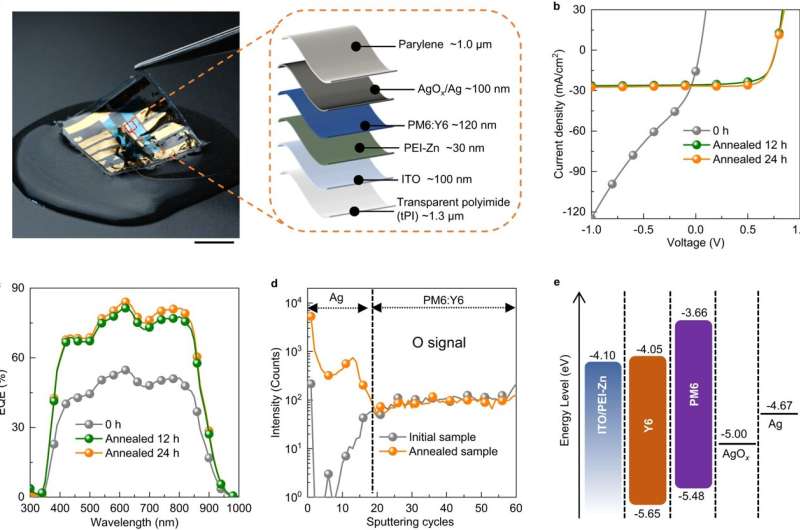This article has been reviewed according to Science X's editorial process and policies. Editors have highlighted the following attributes while ensuring the content's credibility:
fact-checked
peer-reviewed publication
trusted source
proofread
A solar cell you can bend and soak in water

Researchers from the RIKEN Center for Emergent Matter Science and collaborators have developed an organic photovoltaic film that is both waterproof and flexible, allowing a solar cell to be put onto clothes and still function correctly after being rained on or even washed.
One of the potential uses of organic photovoltaics is to create wearable electronics—devices that can be attached to clothing that can monitor medical devices, for example, without requiring battery changes. However, researchers have found it challenging to achieve waterproofing without the use of extra layers that end up decreasing the flexibility of the film.
Now, in work published in Nature Communications, a group of scientists have been able to do precisely that. They took on the challenge of overcoming a key limitation of previous devices, which is that it is difficult to make them waterproof without reducing the flexibility.
Photovoltaic films are typically made of several layers. There is an active later, which captures energy of a certain wavelength from sunlight, and uses this energy to separate electrons and "electron holes" into a cathode and anode. The electrons and holes can then reconnect through a circuit, generating electricity. In previous devices, the layer transporting the electron holes was generally created sequentially by layering.
For the current work, however, the researchers deposited the anode layer, in this case a silver electrode, directly onto the active layers, creating better adhesion between the layers. They used a thermal annealing process, exposing the film to air at 85°C for 24 hours.
According to Sixing Xiong, the first author of the paper, "It was challenging to form the layer, but we were happy to have accomplished it, and in the end were able to create a film that was just 3 micrometers thick, and we looked forward to seeing the results of tests."
What the group saw from the testing was very encouraging. First, they immersed the film completely in water for four hours and found that it still had 89% of its initial performance. They then subjected a film to stretching by 30% 300 times underwater, and found that even with that punishment, it retained 96% of its performance. As a final test, they ran it through a washing machine cycle, and it survived the ordeal, something that has never been achieved before.
According to Kenjiro Fukuda, one of the corresponding authors of the paper, "What we have created is a method that can be used more generally. Looking to the future, by improving the stability of devices in other areas, such as exposure to air, strong light, and mechanical stress, we plan to further develop our ultrathin organic solar cells so that they can be used for really practical wearable devices."
More information: Sixing Xiong et al, Waterproof and ultraflexible organic photovoltaics with improved interface adhesion, Nature Communications (2024). DOI: 10.1038/s41467-024-44878-z

















